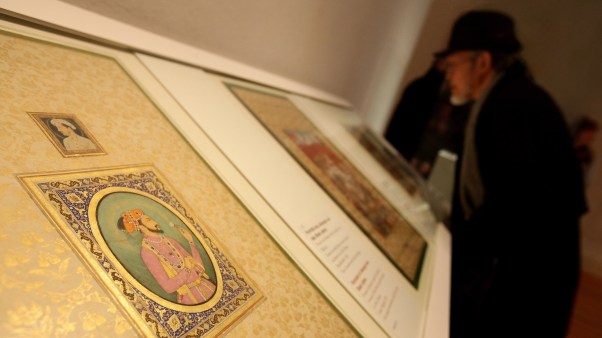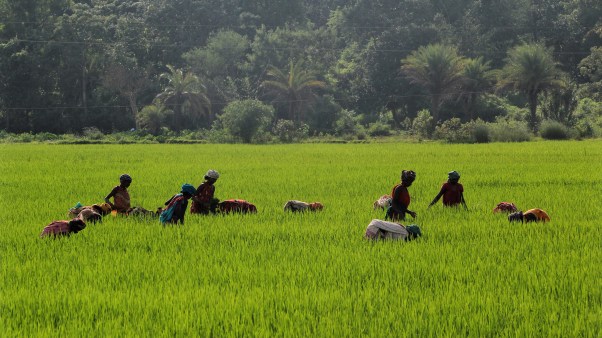Margaret Feinberg longs to see Christians awaken to the culinary themes in Scripture. “Once you start looking for food in the Bible,” she says, “you discover that it pops and sizzles on nearly every page.”
Her spiritual-gastronomic journey began a decade ago, as she researched her book Scouting the Divine: My Search for God in Wine, Wool, and Wild Honey. Through conversations with a vintner, a shepherd, and a beekeeper, Feinberg found that their close connection with these agrarian products transformed the ways they understood certain passages in the Bible. Their responses, in turn, brought new depth to her own reading, too.
Sensing that her work with food was not yet finished, Feinberg probed Scripture for more edible themes. She learned about salt and figs, olives and 18-minute matzoh. Feinberg recently spoke with Christianity Today about her most recent book, Taste and See: Discovering God among Butchers, Bakers, and Fresh Food Makers and the travels she took to research it.
Give us a quick overview of your research process. Where all did you travel in your research?
I went 410 feet down into a salt mine, harvested olives on the coast of Croatia, spent time with one of the world’s premier fig farmers, fished on the Sea of Galilee, and traveled to Yale University to bake matzoh with an expert in ancient grains. With each of these individuals, I opened up the Bible and asked, “How do you read passages related to the food that you plant or procure or process or prepare, not as theologians, but in light of what you do every day?”
Each of these adventures was both a spiritual and a culinary adventure. I got to know the foods—more about their history, more about how they are planted and nurtured and cared for. I learned about the plight of the farmer and the rancher. I learned about the olive oil cartels and so much more. But I also began to discover that when you understand food in the Bible at a granular level, it helps passages come alive in a whole new way.
Tell us a particular story from your travels—an experience that stuck with you and informed your theological understanding of food.
One of my ah-ha moments came from my time in a salt mine [in Salt Lake City, Utah]. I always imagine the salt of the Bible like the highly processed, almost pure sodium chloride that is served on our tables today. But that’s a far cry from antiquity, in which salt was technologically challenging to harvest no matter what its source, whether it was a salt mine, an ocean, or a salty sea.
When I went down into a salt mine, the tunnels we were in weren’t perfectly white. They had these incredible colors of peach garnet and quartz and streaks of brown from the surrounding minerals—from iron and magnesium and dozens of trace minerals all around.
The salt the disciples ate was not pure white. It was hewn with natural minerals around it. When Jesus talks about “the salt of the earth,” he’s not speaking to just pure sodium chloride. He’s speaking to each of us about the natural, unique way we were brought up and created, with our strengths, weaknesses, personalities, quirks, and all of the talents and gifts that God has given us. So when we go out as salt of the earth, we are to walk in fullness of that.
You write about the importance of food throughout the entirety of Genesis, food as part of God’s plan to draw humanity back to himself. Tell us more.
One of the many beautiful stories of God using food to draw people back to himself comes from the Israelites who escape Egypt. They receive that 40-year sabbatical in the Sinai desert. As they wander in the wilderness, they crave the comfort of a life that they had known in Egypt. And yet the Lord responds to their grumbles by providing food. In Elim, he provides drink from the 12 springs and the candy of the 70 date palms. Once they’re in the desert, God sprinkles manna.
This bread is described as tasting like honey, of having the flavor of olives. Through food, God is revealing his own sweetness, his own healing nature. Through food, the Israelites grow dependent on and trust in God. Through food, they discover new ways to think and talk about God as their provider, walking each day in his goodness.
Food is also implicated in the breakdown of creation.
There is no aspect of God’s goodness that has not been distorted. So we should not be surprised in those moments when food, just like the serpent, is a source of temptation—used to manipulate, used to gain power, used to deceive. That is par for the course with many if not most of God’s good gifts.
We live in a culture in the United States where food at the table can be a source of pain, whether it’s wrestling with our weight, wrestling with food addictions, battles with food disorders, or fad diets. For many, food is a place of pain. What the Taste and See book and Bible study does is invite you to take a step back and reexamine food from a biblical perspective and to reexamine your time around the table for what God wants to accomplish there. As you start going through the Scripture, you start to recognize time and time again that even though food was involved in the story of the fall, food is constantly used to call people back to God’s heart.
What do you mean when you call God the “original foodie”?
The term foodie can be intimidating to a lot of people, but a foodie is simply someone who takes a particular interest in food. God has been taking an interest since the beginning of time. He could have made us to be creatures who lick stones and eat rocks. Instead, he embeds our tongues with tens of thousands of taste buds and receptors. He begins the story of creation with foods and textures and tastes of fruits and vegetables that are so beyond our wildest imagination, that are for our pleasure but also reflect his goodness and generosity and endless creativity. This is the God who promises that at the end of time, we will be partaking in the biggest, best banquet.
Food can be a source of daily stress for people around the globe and a symbol of socio-economic inequality. I’m curious what the message of a foodie God means for those who struggle to acquire their daily bread.
I’m going to pass on that question because it’s not the focus of the book. Instead, I’d ask, “How do we who have an abundance of food reconcile with those who do not have food?”
The abundance of food is a living reminder for those who do not have food, and those of us who have an abundance have a responsibility. I know that, for me, the research and study of this book have shifted a lot of my food habits. First, it’s made it so that I eat meat a lot less. I’m very conscious of the amount of meat that I eat, leaning more into a high vegetable diet. It’s also made me live on high alert for food waste.
Where does physical hunger meet spiritual hunger?
Before people come over to my house, I pray for each person and ask God, “Would you show up tonight in our conversations and our time together?” That is the feast that all of our hearts are hungry for.
At the end of the day, the real hunger of our hearts is to know and to be known. To experience and to taste and see God’s goodness together. To be vulnerable, to be comforted, to be challenged. When we shift our focus off of the specific foods to the God who provides the food—and to what he wants to do in our midst and how he wants to open our eyes—that’s where the true transformation happens.









